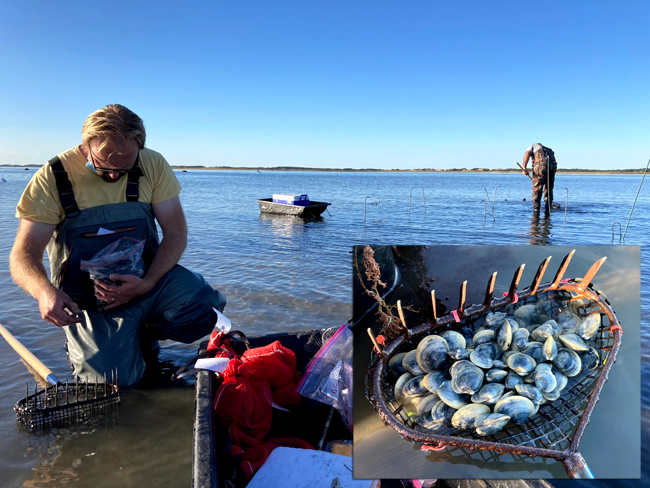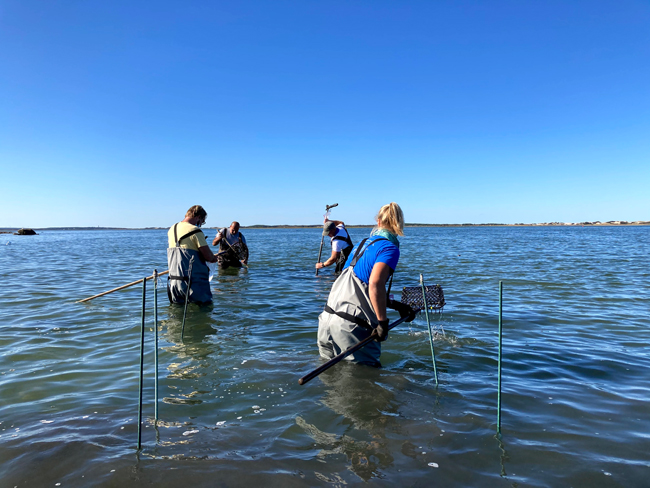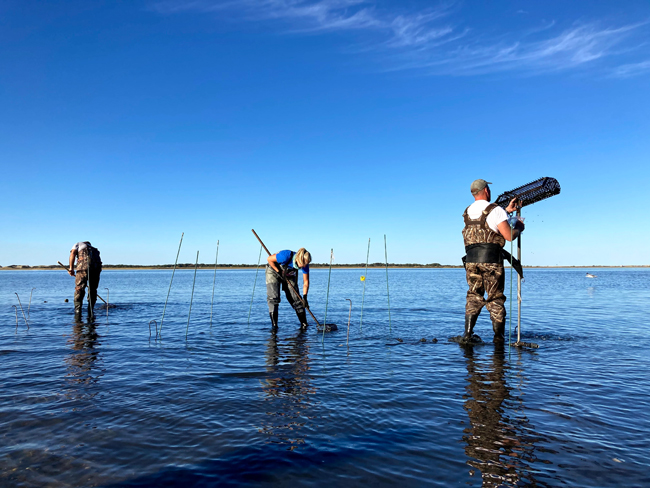
Josh Reitsma, left, collects hard clam samples for study. At the right is Stony Brook University's Bassem Allam, principal investigator; (Inset) The hard clam, or northern quahog, Mercenaria mercenaria. Credit: Abigail Archer
— By Chris Gonzales, Freelance Science Writer, New York Sea Grant
Contact:
Antoinette Clemetson, NYSG Marine Fisheries Specialist, P: 631-632-8730, E: aoc5@cornell.edu
A team of scientists is looking for naturally-occurring clams possessing the best genetic profile for survival under harsh environmental conditions.
Stony Brook, NY, May 2, 2022 - A team of scientists is looking for naturally-occurring clams possessing the best genetic profile for survival under harsh environmental conditions. This work will support the sustainability of aquaculture operations along the East Coast, from New York and Massachusetts to Florida.
Hard clams are a socioeconomically important species: in 2018, the catch in the United States was valued at nearly $62 million. Hard clams, famously, play an important ecological role, transferring energy to sediments on the sea bottom, cycling dissolved nutrients, and filtering the water to make it clearer. They’re key to the marine food web, supporting a variety of predators, including crabs, gastropods, marine birds, and finfish. They are raised for food in aquaculture. The farmers who raise them point to the need for quality seed (the stage before clams mature and reproduce, which farmers grow for the retail market) that can survive under harsh biological and environmental conditions.
Compared to the eastern oyster, which suffers from several diseases, the hard clam (Merceneria mercenaria) is a relatively hardy species. The scientists’ current project, however, focuses on two challenges that have been delivering a one-two punch since the 1990s: an illness called QPX disease and warming coastal waters.
The team, called the Hard Clam Selective Breeding Collaborative, is led by Bassem Allam, a bivalve pathologist at Stony Brook University. The project is funded by the National Sea Grant College Program and administered by New York Sea Grant. The collaborative will work with all the major hard clam–producing states on the eastern seaboard.

Members of the research team dig clams to assess their health and survivorship. From left to right: Josh Reitsma, Bassem Allam, Matt Weeks, and Harriet Booth. Credit: Abigail Archer
Seeking Resilience
Since susceptibility to QPX disease is a heritable trait (in other words, due to genetics), scientists are hoping to use genomic methods to identify this trait and selectively breed resistant clam lines.
Advances in gene sequencing technologies have made it far cheaper and more efficient for scientists to explore the genomes of various plants and animals. Prior to the mid-2000s, this ability generally was limited to cows, corn, and salmon. Now, this technology is being applied in many other areas of biology.
The team has recently assembled the hard clam genome. They are currently using this genome as a reference to identify genetic markers associated with clam resistance to QPX disease and warmer ocean waters. They will use this knowledge to selectively breed animals bearing those markers and produce clams resistant to these stressors.
Stressed Clams
As part of the project, the team will pilot a model to establish this regional hard clam breeding program linking scientists, extension personnel, and industry leaders. By providing these resilient stocks, the group is removing production barriers and bottlenecks for hard clam that are posed by these biological and environmental stressors.
Advancements in Selective Breeding
Traditional selective breeding has had some success producing clams with more durable shells and disease resistance.
Allam's team has already found numerous RNA sequence details that relate to the hard clam's resilience to warming, ocean acidification, and QPX.
Researchers are now hunting for single-nucleotide polymorphisms, or SNPs, a mainstay of genetic mapping. A SNP is a variation at a single location in a DNA sequence from an individual organism—even a human1. These SNPs (or "snips") can cause genetic disease, for example, or can confer resistance to an infectious disease.
These tools have previously been used in catfish, carp, Atlantic salmon, rainbow trout, and the Pacific oyster, all major farmed seafood. This project will produce a SNP array for the hard clam, and the ultimate goal in the first phase of this work will identify populations of clams able to resist QPX disease and warmer ocean waters.

Nearly half of the town of Wellfleet is part of the Cape Cod National Seashore. From left to right: Allam, Booth, and Weeks. Credit: Abigail Archer
How bad is QPX disease in clams?
We ask shellfish grower Andrew Cummings of Wellfleet, Massachusetts
QPX is more extreme than other shellfish diseases. With other diseases, you can manage around them, even prevent illness. QPX is drastic. It spreads quickly. It’s hard, almost impossible, to get rid of it.
“Back in 2003, I bought some seed [to grow clams],” said Andrew Cummings of Wellfleet, Massachusetts—a town famous for its oysters, halfway between the “tip” and “elbow” of Cape Cod. “Some other growers in my area also bought seed from the same batch. Our problems all started with a very high clam mortality. My clams were in a subtidal zone, thus always underwater. They suffered mortality at a much higher rate, and much faster, than clams raised in an intertidal zone.”
He took some samples to Cooperative Extension. They had the pathology results within a week. “It’s QPX,” they told him.
In some places, QPX can exist naturally in the background at a level where the environment can handle it. However, in places where it is newly introduced, the environment has no defense against it.
“We had industry and state officials come by. It might have been easier just to keep quiet about it but we were vocal about it,” said Cummings. “We made the difficult decision to dig up and destroy all those animals. It was millions [of clams].”
They dug them, got them out, destroyed them. They had train-car–size dumpsters. The clams were carted to a landfill. In many cases, these were market-ready clams. You can legally sell them, and it’s not harmful to consume them. It was hundreds of thousands of dollars of product, Cummings noted. “We started pulling them out on Thanksgiving, and finished on Valentine’s Day. It was a long haul.”
Now they have little flare-ups here and there. It could have been worse. Cummings no longer raises clams. QPX wasn’t the only reason, but it was part of the straw that broke the camel’s back. He now focuses on growing oysters, which do have some diseases, but they are much more manageable.
References
1 Scitable by Nature Education
Story Map: Sea Grant Hard Clam Selective Breeding Collaborative
More Info: New York Sea Grant
New York Sea Grant (NYSG), a cooperative program of Cornell University and the State University of New York (SUNY), is one of 34 university-based programs under the National Oceanic and Atmospheric Administration’s National Sea Grant College Program.
Since 1971, NYSG has represented a statewide network of integrated research, education and extension services promoting coastal community economic vitality, environmental sustainability and citizen awareness and understanding about the State’s marine and Great Lakes resources.
Through NYSG’s efforts, the combined talents of university scientists and extension specialists help develop and transfer science-based information to many coastal user groups—businesses and industries, federal, state and local government decision-makers and agency managers, educators, the media and the interested public.
The program maintains Great Lakes offices at Cornell University, University at Buffalo, SUNY Oswego and the Wayne County Cooperative Extension office in Newark. In the State's marine waters, NYSG has offices at Stony Brook University and Cornell Cooperative Extension of Nassau County on Long Island; at Brooklyn College, with New York City Department of Environmental Protection in Queens and at Cornell Cooperative Extension in NYC and Elmsford and Kingston in the Hudson Valley.
For updates on Sea Grant activities: www.nyseagrant.org has RSS, Facebook, Twitter, Instagram, and YouTube links. NYSG offers a free e-list sign up via www.nyseagrant.org/nycoastlines for its flagship publication, NY Coastlines/Currents, which is published quarterly.